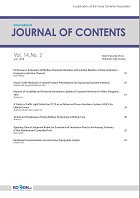- 권한신청
- P-ISSN1738-6764
- E-ISSN2093-7504
- KCI
 ISSN : 1738-6764
ISSN : 1738-6764
Study on Agenda-Setting Structure between SNS and News:Focusing on Application of Network Agenda-Setting
고태성 (성균관대학교)
강보영 (성균관대학교)
차민경 (한국문화관광연구원)
Se-Jin Kim (School of Media, Korea Culture Tourism Institute)
Hea-Ji Kweon (Business Administration Seoul National University)
Abstract
This study applied network agenda-setting theory to analyze the impact of the agenda-setting function of the media on certain issues by focusing on the agenda at the center of controversy, ‘Creative Economy’. To this end, the study extracted the data referred to creative economy in the media and SNS from 1 January 2008 to 31 December 2014, and analyzed the data using the network analysis program UCINET and the Korean language analysis program Textom. The results of the present study show that, during the period under former President Lee (2008-2011), the media’s creative economy agenda-setting function did not exert a significant impact on the agenda-setting within SNS. However, from 2012 when the government of former President Park Geun-hye had started, the agenda-setting function of the media starts to show increasingly strong influence on the agenda cognition in SNS. The central words and sub-words configuration forming the center of the semantic network moved in the direction of a high correlation, in addition to the gradually increasing correlation based on QAP correlation analysis. In 2014, the semantic networks of the media and SNS bore a close resemblance to each other, while the shape of networks and sub-words structure also had a high level of similarity.
- keywords
- Network, Agenda-setting, Creative Economy, SNS, Semantic Networks, QAP Analysis
- 다운로드 수
- 조회수
- 0KCI 피인용수
- 0WOS 피인용수

